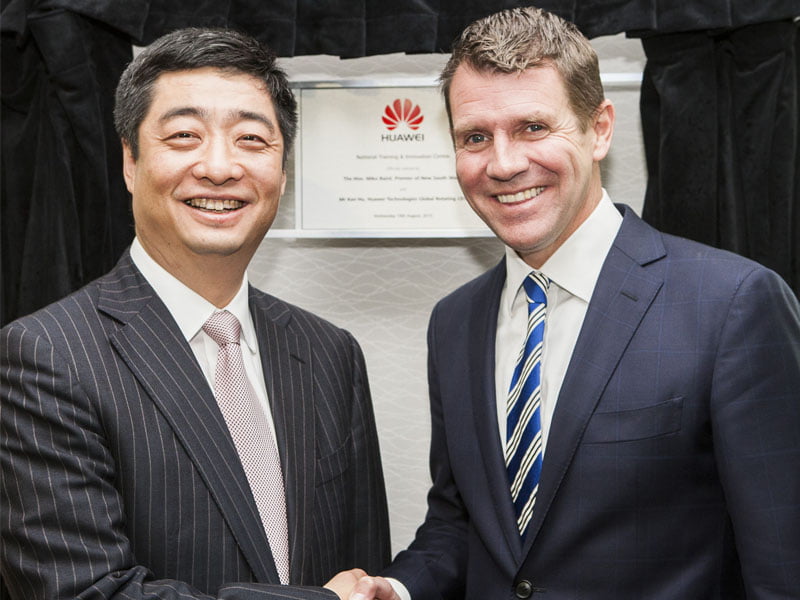It’s not often Australia hosts the global CEO of a multinational technology outfit. That changed briefly last week when networking giant Huawei’s chief executive, Ken Hu, shared a platform in Sydney with NSW Premier Mike Baird.
There was a time – when dinosaurs and mainframe vendors roamed the earth – when these global industry captains would visit regularly, usually as part of a swing through Asia. These days, not so much.
Huawei continues to court the Australian market aggressively. It is applying relentless soft-power charm to the task of building and sustaining a close relationship between Australia’s and China’s technology sectors.

To my mind, this makes Huawei the most important multinational tech company currently operating in Australia. It is important that our policy-makers recognise this.
Certainly it is a welcome sign that the NSW Premier is happy and comfortable about providing such a public display of affection.
Mr Baird and Mr Hu were opening Huawei’s $30 million National Training and Innovation Centre at the company’s Aussie HQ in Chatswood. The investment is an extension of Huawei’s 16 R&D centres and 28 joint-innovation centres around the world.
These relationships are critical. If Australia is to have any chance of diversifying its trade relationship with China in a meaningful way, it must grab these opportunities. (Are we seriously to think that the highlight of a diversified trade rests with a huge expansion of the live cattle trade with China? Can we also get serious about our own tech smarts?)
Huawei is an important bridge for understanding both the China market, and the China technology engine. Because we know – or we should know – that by virtue of the scale of the China R&D engine, that it will play an expanded role in setting global technology standards in the coming years.
Of the elephants in the room at the innovation centre launch last week, the well-documented adverse technical assessment of Huawei by Australian security agencies is obviously the biggest. It hangs over the relationship like a variety of metaphors.
It is impossible to know what the assessment says. But it is still precluded from tendering for work on the National Broadband Network or core government networks. And the ban, first put in place during the first Rudd Government, was reaffirmed by the current Attorney-General George Brandis last year.
In the meantime, Huawei has pressed its public charm offensive to new heights (and no doubt its back channel pressure on government).
We need to be sensible about this. The relationship that the Australian technology sector has with Huawei is emblematic of the broader China relationship. It is complicated and multi-faceted, and is a work in progress.
The key word here is work. There is work to be done, and right now and it has been Huawei doing the heavy lifting. With any relationship, you need to – as Sam Cooke once told me – accentuate the positive.
So for a moment let’s look at the positives. Australia already enjoys a special status with the Huawei organisation. It is seen as a key strategic market for the company. It is the only subsidiary with its own board of directors, and the board has made the better integration of Australian suppliers into the global supply chain a corporate priority.
On weight of numbers, Huawei is a giant. Nearly half of its 170,000 employees (about 45 per cent) work directly in R&D activities. And with the creation of the Sydney innovation centre, the local office will be contributing to the global tech development effort.
Huawei spends about 10 per cent of revenue on R&D, and has spent this about since its earliest days. The company employs 600 people in Australia, with about 450 in Sydney. The company’s corporate ethos – like so many others, wherever they are headquartered – is on innovation and human capital development.
Huawei CEO Ken Hu says the company is investing in its innovation centre here, both to take advantage of excellent technical skills in Australia – just like its US counterparts – and to help develop that talent pool.
Huawei Australia Chairman John Lord – the former Royal Australian Navy rear admiral – says the local company has four pretty straight-forward objectives.
First, make a profit. Second, find ways to bring Australian companies and people into the Huawei global supply chain (in which he says Australians are under-represented). Third, to bring innovation and R&D functions here to Australia.
And finally, to help Australians and Chinese learn more about each other – both inside and outside of the technology sector.
Whatever complexity there is in the Australia-China relationship, it has not stopped Huawei’s push into this market, nor dented the company’s enthusiasm for building bridges between the Australian tech sector and China’s.
Huawei continues to invest heavily in the relationship – from sponsoring a rugby league team at one end of the spectrum, to inviting our brightest students to Shenzhen for a cultural exchange at the other.
This is the projection of soft power in its classic sense, and has been the playbook of any number of national and corporate powers doing business on our shores. It works, and we should be embracing it.
The New South Wales government has been a key driver in building its China relationship, and especially in building links beyond the resources boom. Barry O’Farrell turned the switch, and now Mike Baird has continued to run with it.
The Canberra-Beijing partnership is fundamental to our economic well-being and strategic security. And the New South Wales-Guangdong relationship is the central pillar within that relationship.
In the context of an Australian tech sector, Shenzhen-based Huawei’s interest in this country is an opportunity.
Do you know more? Contact James Riley via Email.

